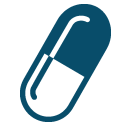ADHD is a common brain developmental disorder that results in ongoing patterns of inattention, impulsivity, and/or hyperactivity that interfere with daily life. These symptoms occur because the brain doesn’t fully develop its network of neurons and doesn’t efficiently use neurotransmitters to send messages from the brain to the rest of the body.
Despite knowing that rates of ADHD are equal in men and women, women continue to be significantly underdiagnosed.
Dopamine is one of the neurotransmitters involved in ADHD. Estrogen and dopamine have a regular cycle, where dopamine increases when estrogen increases because estrogen stimulates new dopamine production.
When estrogen starts to decline in perimenopause, dopamine levels also decline. For women without ADHD, this makes their symptoms worse. For women without ADHD, the decrease in dopamine can actually cause the same impairments in brain function that are seen in ADHD women. The decreased levels of estrogen and dopamine mimic the impact of this brain disorder
What is ADHD?
Attention Deficit Hyperactivity Disorder (ADHD) is a neurodevelopmental disorder defined by a consistent pattern of inattention and/or hyperactive impulsivity that interferes with daily functioning. Globally, ADHD affects 2.5% – 6.7% of adults. Although it has long been conceptualized as a disorder of childhood, one study found that 75% of adults with ADHD were not previously diagnosed in childhood.[1] [2]
Additionally, women are seriously underdiagnosed, even as children. ADHD continues to be perceived as a hyperactive boy disorder. However, ADHD in girls and women usually presents very differently from ADHD in boys and men. This is why boys get diagnosed with ADHD nine times more frequently than girls.
The sharp increase over the last few years in diagnosing ADHD in adult women is linked to women trying to get their ADHD children help and recognizing themselves in the pamphlets and questionnaires. In fact, the percentage of women newly diagnosed with ADHD between 23–49 years of age nearly doubled from 2020 to 2022. [3]
Adult women with ADHD are more likely to get a diagnosis of Major Depressive Disorder or Bi-Polar Disorder instead of the correct ADHD diagnosis. These incorrect diagnoses are happening because doctors are not educated on ADHD symptomatology in girls and women.
ADHD is caused by a combination of genetic, neurobiological, and environmental factors. Studies have shown that ADHD is highly inheritable, so that parents with ADHD have a 60–70% chance of passing their ADHD onto their children. Environmental risk factors such as complications at birth or exposure to toxic materials in utero also play a role. Brain scans indicate that the pre-frontal cortex is underdeveloped in men and women with ADHD directly causing the symptoms. [1]

What Are ADHD Symptoms?
Women with ADHD may find it hard to focus and remember events causing challenges in all domains of life. Unfortunately, many women with ADHD are completely unaware and do not understand that their symptoms are based in their brain chemistry, not in personal flaws such as being lazy or weak-willed. This often leads to severe self-criticism, self-hatred, depression, and anxiety.
People with untreated ADHD have a higher risk of substance use, car accidents, unintentional injuries, depression, anxiety, and suicide or self-harming behaviours. In other words, underdiagnosis has significant implications, far beyond inability to focus.[4][5]
If you are experiencing any of these, talk to trusted people around you to see if they have noticed any symptoms. Then talk to your healthcare provider so you can first name and then start assessing your symptoms to find solutions that work for you.
Female ADHD symptoms may include:
- Impulsiveness
- Disorganization
- Problems prioritizing tasks
- Poor time management skills
- Problems focusing on a task
- Poor working memory
- Trouble multitasking
- Excessive activity or restlessness, physical and mental
- Poor planning
- Easily frustrated and irritated
- Frequent mood swings
- Problems following through and completing tasks
- Strong emotions
Did you know?
Self-care and Natural Remedies for Symptoms of ADHD
Women with ADHD often blame themselves for their shortcomings, because they do not understand that their brains are ‘neurodivergent’ and work differently from ‘neurotypical’ brains. This can lead to substance abuse, low-self esteem, self-hatred, self-harm, social isolation, and negative self-talk. If you know or suspect that you (or a loved one) may have ADHD, being kind to yourself is key to managing your symptoms.
Therapies and Treatments for ADHD and Menopause
If you’re experiencing ADHD symptoms (with or without a diagnosis), seek help. A diagnosis is required to get medication, but there are many other treatments and therapies that are part of a regular ADHD treatment plan.
The Science
Research has shown that ADHD is associated with weaker function and structure of prefrontal cortex (PFC) circuits that form connections with other regions of the brain. One of these, the prefrontal association cortex, is critical for regulating attention, behavior, and emotion, and behavioral inhibition. Proper functioning of the prefrontal cortex also depends on access to the appropriate levels of the neurotransmitters dopamine, norepinephrine, and epinephrine. [9]

Estrogen and Dopamine
Estrogen is a steroid hormone that regulates reproduction and sexual development in females. Estrogen, however, also serves as a ‘master regulator’ because it impacts many other body systems and functions.
Dopamine is a neurotransmitter that is made in your brain. It is known as the ‘feel-good’ molecule, because it is part of the brain’s reward center. When you complete a positive task or behaviour, dopamine is released, producing feelings of pleasure, satisfaction and motivation. It also plays a role controlling memory, mood, sleep, learning, concentration, movement and other body functions. [12]
Estrogen directly impacts dopamine levels in the brain. It increases the amount of dopamine available for your brain to use by boosting the amount of dopamine that is made. At the same time, it reduces the amount of dopamine that gets removed from the system through natural breakdown, and the amount that gets recycled during the reuptake process.
This connection between dopamine and estrogen is the likely root cause of some menopause symptoms including mood changes. When estrogen levels decrease, usable dopamine levels decrease. In fact, data from a recent study shows that women with ADHD suffer a 2-3 fold increase in frequency and severity of mood changes during the menopause transition. [6] [10] [13]
Myths & Mysteries
No, although for many years boys received almost all of the ADHD diagnoses. This is because ADHD presents differently in boys and girls. For example, hyperactivity in boys is obvious – they can’t sit still or pay attention. Hyperactive girls, on the other hand, typically internalize their hyperactivity so it shows up as a chaotic mind (which they usually hide) and / or a hyperverbality where they talk all the time.
No it isn’t. Some people with ADHD also have learning challenges (including dyslexia), but those have no impact on IQ. People with ADHD are absolutely capable of being CEOs, surgeons, academics, and entrepreneurs, just like any other non-ADHD person.
ADHD is a neurological development condition, and to receive a diagnosis, symptoms have to have been present in childhood. However, estrogen is involved in the production of the neurotransmitters that can cause ADHD symptoms, so changes to your estrogen levels can affect whether or not you experience symptoms. The root cause is different, but the effects and the symptoms show up in the same way.
Yes absolutely. If you have been formally diagnosed with ADHD, you may be prescribed medications that will impact your brain chemistry and improve your symptoms. Medication is rarely enough on its own, however, so talk therapy, especially cognitive behavioural therapy (CBT) can be very helpful as well.
Compiled References
[1] Abdelnour E, Jansen MO, Gold JA. ADHD Diagnostic Trends: Increased Recognition or Overdiagnosis? Mo Med. 2022 Sep-Oct;119(5):467-473. PMID: 36337990; PMCID: PMC9616454.
[2] https://www.additudemag.com/adhd-symptoms-checklist/
[3] https://epicresearch.org/articles/number-of-adhd-patients-rising-especially-among-women
[4] https://www.mayoclinic.org/diseases-conditions/adult-adhd/symptoms-causes/syc-20350878
[5] www.nimh.nih.gov/health/topics/attention-deficit-hyperactivity-disorder-adhd
[6] Kooij JS. Hormonal sensitivity of mood symptoms in women with ADHD across the lifespan. Eur Psychiatry. 2023 Jul 19;66(Suppl 1):S23. doi: 10.1192/j.eurpsy.2023.92. PMCID: PMC10417850.]
[7] https://www.additudemag.com/cognitive-behavioral-therapy-for-adhd
[8] https://www.healthline.com/health/cbt-techniques
[9] Arnsten AF. The Emerging Neurobiology of Attention Deficit Hyperactivity Disorder: The Key Role of the Prefrontal Association Cortex. J Pediatr. 2009 May 1;154(5):I-S43. doi: 10.1016/j.jpeds.2009.01.018. PMID: 20596295; PMCID: PMC2894421.
[10] https://www.absoluteadvocacy.org/dopamine-and-estrogen-a-surprising-relationship
[11] https://www.webmd.com/add-adhd/adhd-nonstimulant-drugs-therapy
[12] https://my.clevelandclinic.org/health/articles/22581-dopamine
[13] Del Rio JP, et. al. Frontiers of Public Health, 23 May 2018, Volume 6 – 2018 | https://doi.org/10.3389/fpubh.2018.00141
Not AI generated.
Original content, last updated February 7, 2024.
© 2024 Herstasis® Health Foundation












